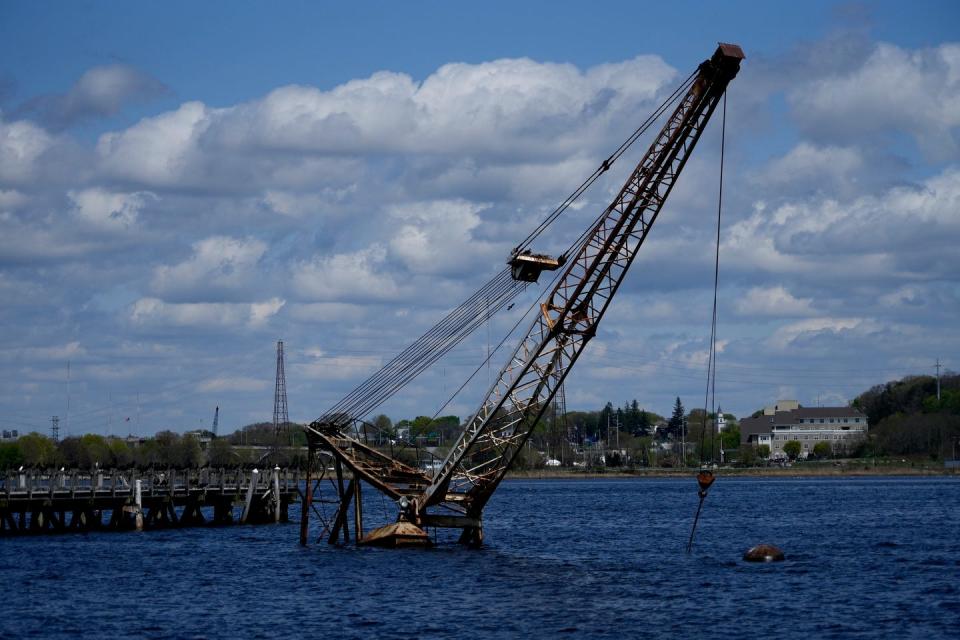How a new project aims to restore Providence River habitat and empower city residents
PROVIDENCE – A federal grant awarded to the city not only aims to restore habitats near the Port of Providence but also to empower residents with more of a voice in projects that would enhance the shoreline and help protect it from rising seas and storm surges.
The $492,000 grant from the National Oceanic and Atmospheric Administration’s Climate-Ready Coasts Initiative will fund a big-picture assessment of the stretch of shoreline along the Providence River that runs north of the port from Sassafras Cove to Collier Point Park.
It’s a heavily industrialized area that includes the former Conley's Wharf and the vacant Providence Gas Company building, as well as scrap-metal businesses Sims Metals Management and problem-plagued Rhode Island Recycled Metals. It’s also where the notorious wreck of a barge is half-submerged in the river, its crane clearly visible above the waterline.
But there’s impetus behind improving the waterfront after the reopening two years ago of Public Street as a shoreline access point. And there’s interest in natural solutions to shield the low-lying area from rising seas and to absorb floodwaters. Conducting an analysis of potential habitat restoration opportunities is the next logical step.

More: 5 years later, are there plans for the sunken barge in the Providence River? What we know
Grant will help ensure residents have their voices heard in projects that affect them
What’s more unusual about the NOAA-funded project is that it’s also paying to educate community members about the possibilities for the area and teach them about city and state planning processes to help ensure that their opinions are taken into account.
Starting in 2024 and continuing in 2025 and 2026, classes of 18 people recruited from the South Providence and Washington Park neighborhoods will go through a year-long training program that will include segments on climate change and stormwater.
That sort of formal coursework is necessary especially to understand the ever-changing data of climate vulnerabilities, said Michele Jalbert, executive director of Providence Resilience Partnership, a nonprofit that coordinated the application for the grant.
More: Giant RI sewer project is cleaning Narragansett Bay. But is it too costly for ratepayers?
“It’s making it possible for residents to be more effective advocates for their community,” she said.
The program is being modeled on similar training conducted by PVD Tree Plan, in which residents learn about the benefits of tree-planting, and Nuevas Voces at the Water Table, an initiative created by the Woonasquatucket River Watershed Council to train environmental advocates.
The work done by the Woonasquatucket council may be a particularly apt guide for the Providence River project. The council has been one of the drivers of the clean-up of once-blighted properties in Olneyville. It has expanded its mission from improving water quality in the river to helping build playgrounds and, more recently, to reducing the impacts of flooding in the watershed.
Nuevas Voces (Spanish for new voices) started in 2021 as a way to connect residents in the communities that were suffering the effects of environmental problems with agencies and city leaders who could do something about them.
The educational component of the Providence River project will be coordinated by Groundwork Rhode Island, one of the partners in PVD Tree Plan.
“I think this is a long-term investment in building leadership, building awareness and building buy-in from the beginning,” said Amelia Rose, executive director of Groundwork Rhode Island.
The curriculum for the training program won’t be finalized until the fall but it will touch on stormwater management, ways that marsh plants or oyster beds can protect from floodwaters, and future plans for the Port of Providence area. Rose said it will also include a boat tour and visit to the headquarters of Save The Bay, another one of the project partners.
The Save The Bay center, which sits on a former city landfill south of the port on Fields Point, offers an example of what can be done to rehabilitate industrial waterfront land.
“We can share lessons from our site,” said Wenley Ferguson, director of habitat restoration for Save The Bay. “We want to look at what this shoreline could be. How can we restore the community’s connection to it?”
Since its founding three years ago, the Providence Resilience Partnership has been pushing to better protect Rhode Island’s capital city from the impacts of climate change.
The group helped secure a $1-million federal allocation to study whether the Fox Point Hurricane Barrier needs to be improved because seas are rising and storm patterns are changing. The grant for the Providence River project addresses another point of vulnerability in the city.
But Jalbert said more needs to be done to come up with a citywide resilience plan.
“We need to take all of this emerging data and we need to bring it together so we have a full picture,” she said.
This article originally appeared on The Providence Journal: New NOAA-funded project will restore habitats near Port of Providence

